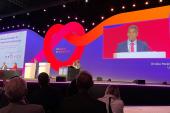ESC Cardiomyopathy Guidelines Span Range of Phenotypes
The first-of-its-kind document endorses multimodality imaging to make more precise diagnoses and allow for patient-tailored care.

With developments in imaging and genetic testing over the past decade that enable clinicians to better identify and treat a range of cardiomyopathies, the European Society of Cardiology (ESC) this week published its first broad set of guidelines dedicated to these conditions.
The document breaks down cardiomyopathies into different phenotypes—including hypertrophic, dilated, nondilated left ventricular, arrhythmogenic right ventricular, and restrictive—and recommends different diagnosis and management strategies for these conditions that affect about one in 250 people worldwide.
This is the first international guideline to combine “all the cardiomyopathies in one single document,” including both those that are hereditary and those that are not, writing committee co-chair Elena Arbelo, MD, PhD (Universitat de Barcelona, Spain), told TCTMD. Previous guidelines in this space have solely focused on hypertrophic cardiomyopathy, she said.
“In the past probably 10 years, there have been significant improvements in imaging techniques, particularly magnetic resonance, and also in the genetic testing field,” Arbelo continued. “Through those means, we have learned a lot more about the different types of cardiomyopathies—not only to diagnose, but there has also been some improvement in predicting the risk of progression to heart failure and sudden cardiac death.”
Dedicated treatments also have emerged in this time.
The guidelines, which were published this week in the European Heart Journal and presented at the ESC Congress 2023, are endorsed by the Association of Cardiovascular Nursing & Allied Professions, European Association of Cardiovascular Imaging, European Association of Preventive Cardiology, European Heart Rhythm Association, and Heart Failure Association.
Precise Evaluation, Diagnosis
The guidelines were designed to endorse a patient- and family-centered strategy, Arbelo explained. “In this way, using a structured approach, you can go from these clinical suspicions to describing the phenotypes, or the characteristics, of the cardiomyopathy and then using additional traits that include a family evaluation, genetic testing, imaging, labs, and other traits and red flags that may suggest a specific diagnosis,” she said. “This more precise diagnosis is going to allow specific treatments, specific decisions in risk stratification, for instance, that will allow for better management.”
The guidelines endorse all patients with suspected cardiomyopathies to undergo echocardiography (class 1, level of evidence B) as well as contrast-enhanced cardiac magnetic resonance (CMR) imaging (class 1, level of evidence B) as “noninvasive imaging modalities represent the backbone of diagnosis and follow-up in patients with cardiomyopathies.”
Genetic testing and counseling are also recommended for patients and families with or at risk for inherited cardiomyopathies (class 1, level B) as some of these patients may live with a small risk of sudden death. Lifestyle and family planning can also be affected by information gleaned from these tests, the guidelines specify.
For those already living with cardiomyopathy, the guidelines provide a range of suggestions on exercise, diet, alcohol, weight, reproduction, sexual activity, medication, vaccination, driving, employment, holidays and travel insurance, and life insurance.
Notably, the guidelines state that Takotsubo syndrome, which is oftentimes referred to as stress cardiomyopathy, has been thought to fit into this category of cardiomyopathies but should not be classified as such. “It's a transient dysfunction of the heart due to stress mainly,” Arbelo said. “There is no proof yet that there is a specific genetic background or a structural abnormality that support the definition of cardiomyopathy.”
Paradigm Shift
Ultimately, Arbelo said she’d like to see the current paradigm shift so that cardiomyopathy patients are no longer only managed by “superspecialized centers,” but rather by their general adult or pediatric cardiologist in collaboration with these institutes.
As such, the target audience for these guidelines should be all the general cardiovascular healthcare professionals, she said. “But the nice thing about the document is that it highlights the importance of multidisciplinary approach.”
Because much of the evidence gathered on cardiomyopathies has come from observational studies, Arbelo said more research is needed especially to further improve the precision of phenotyping and risk stratification. With these findings, more specific treatments are also likely to follow, she added.
Yael L. Maxwell is Senior Medical Journalist for TCTMD and Section Editor of TCTMD's Fellows Forum. She served as the inaugural…
Read Full BioSources
Arbelo E, Protonotarios A, Gimeno JR, et al. 2023 ESC guidelines for the management of cardiomyopathies: developed by the task force on the management of cardiomyopathies of the European Society of Cardiology (ESC). Eur Heart J. 2023;Epub ahead of print.
Disclosures
- Arbelo reports no relevant conflicts of interest.





Comments